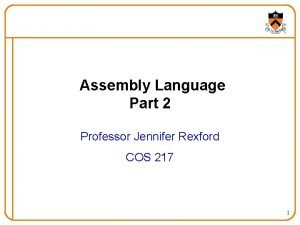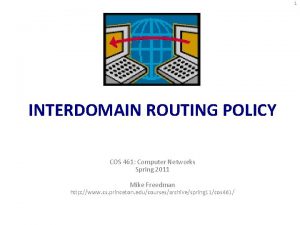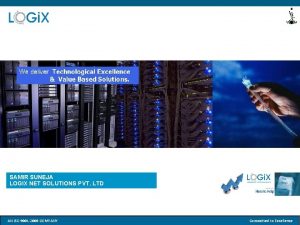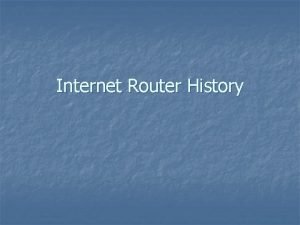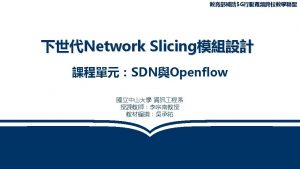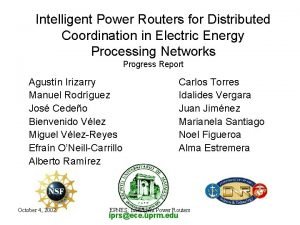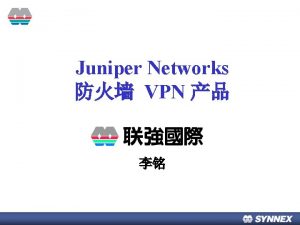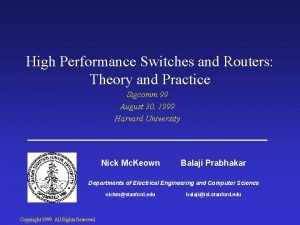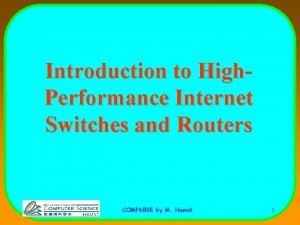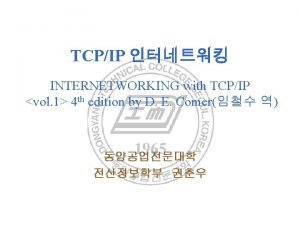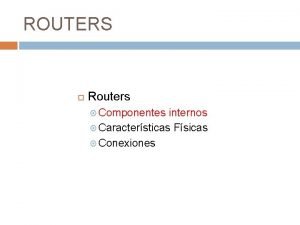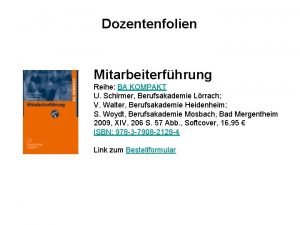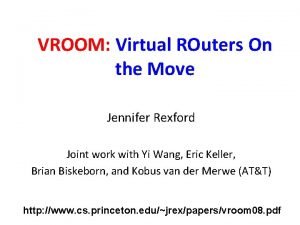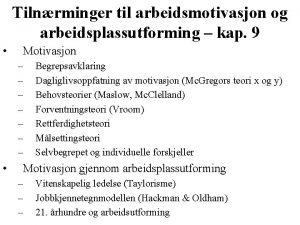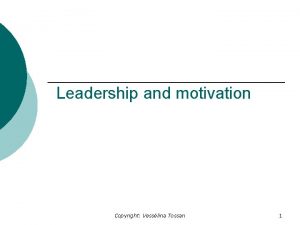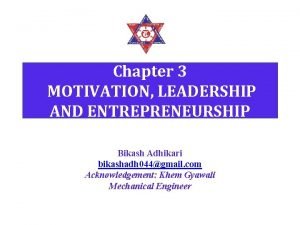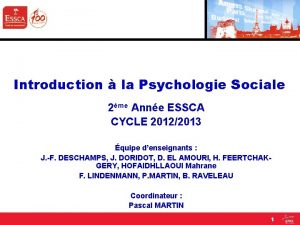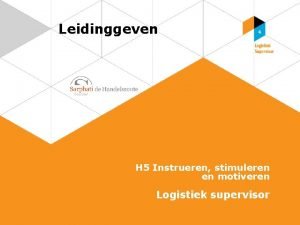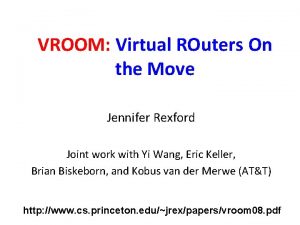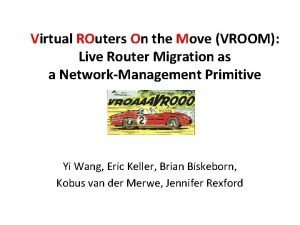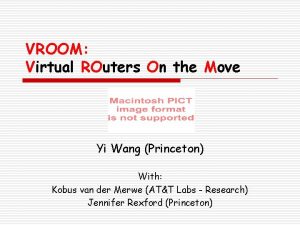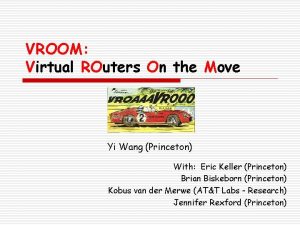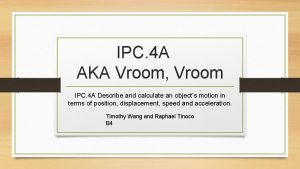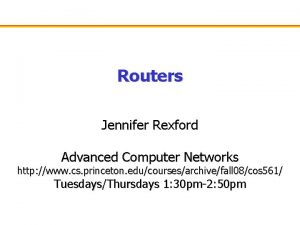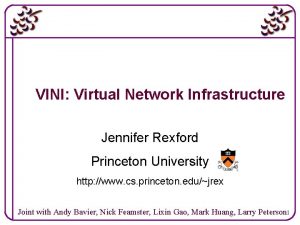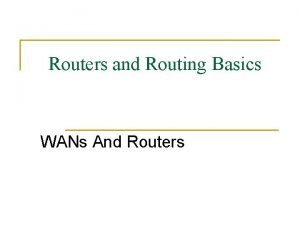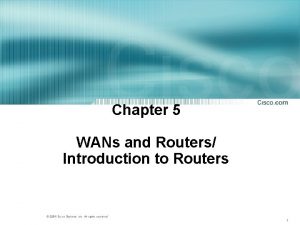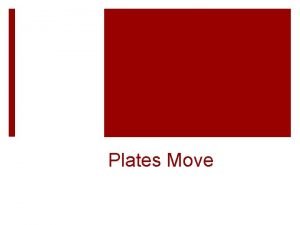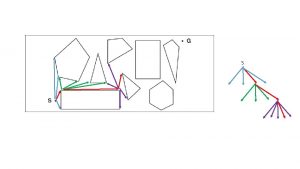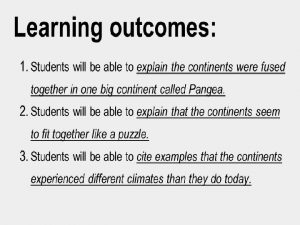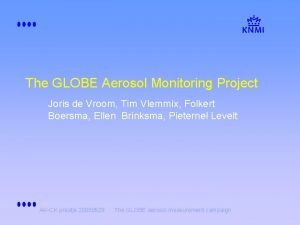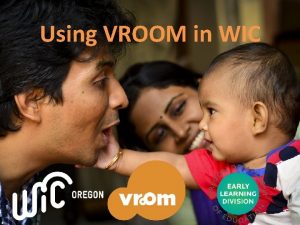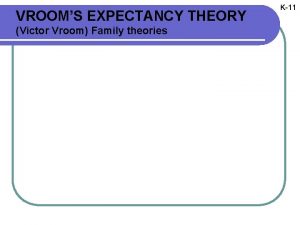VROOM Virtual ROuters On the Move Jennifer Rexford








































- Slides: 40

VROOM: Virtual ROuters On the Move Jennifer Rexford Joint work with Yi Wang, Eric Keller, Brian Biskeborn, and Kobus van der Merwe (AT&T) http: //www. cs. princeton. edu/~jrex/papers/vroom 08. pdf

Virtual ROuters On the Move • Key idea – Routers should be free to roam around • Useful for many different applications – Simplify network maintenance – Simplify service deployment and evolution – Reduce power consumption –… • Feasible in practice – No performance impact on data traffic – No visible impact on routing protocols 2

The Two Notions of “Router” • IP-layer logical functionality, and physical equipment Logical (IP layer) Physical 3

Tight Coupling of Physical & Logical • Root of many network-management challenges (and “point solutions”) Logical (IP layer) Physical 4

VROOM: Breaking the Coupling • Re-mapping logical node to another physical node VROOM enables this re-mapping of logical to Logical physical through virtual router migration. (IP layer) Physical 5

Case 1: Planned Maintenance • NO reconfiguration of VRs, NO reconvergence VR-1 A B 6

Case 1: Planned Maintenance • NO reconfiguration of VRs, NO reconvergence A VR-1 B 7

Case 1: Planned Maintenance • NO reconfiguration of VRs, NO reconvergence A VR-1 B 8

Case 2: Service Deployment/Evolution • Move (logical) router to more powerful hardware 9

Case 2: Service Deployment/Evolution • VROOM guarantees seamless service to existing customers during the migration 10

Case 3: Power Savings • $ Hundreds of millions/year of electricity bills 11

Case 3: Power Savings • Contract and expand the physical network according to the traffic volume 12

Case 3: Power Savings • Contract and expand the physical network according to the traffic volume 13

Case 3: Power Savings • Contract and expand the physical network according to the traffic volume 14

Virtual Router Migration: Challenges 1. Migrate an entire virtual router instance • All control plane & data plane processes / states 15

Virtual Router Migration: Challenges 1. Migrate an entire virtual router instance 2. Minimize disruption • • Data plane: millions of packets/sec on a 10 Gbps link Control plane: less strict (with routing message retrans. ) 16

Virtual Router Migration: Challenges 1. Migrating an entire virtual router instance 2. Minimize disruption 3. Link migration 17

Virtual Router Migration: Challenges 1. Migrating an entire virtual router instance 2. Minimize disruption 3. Link migration 18

VROOM Architecture Data-Plane Hypervisor Dynamic Interface Binding 19

VROOM’s Migration Process • Key idea: separate the migration of control and data planes 1. Migrate the control plane 2. Clone the data plane 3. Migrate the links 20

Control-Plane Migration • Leverage virtual server migration techniques • Router image – Binaries, configuration files, etc. 21

Control-Plane Migration • Leverage virtual server migration techniques • Router image • Memory – 1 st stage: iterative pre-copy – 2 nd stage: stall-and-copy (when the control plane is “frozen”) 22

Control-Plane Migration • Leverage virtual server migration techniques • Router image • Memory CP Physical router A DP Physical router B 23

Data-Plane Cloning • Clone the data plane by repopulation – Enable migration across different data planes – Avoid copying duplicate information Physical router A DP-old CP Physical router B DP-new 24

Remote Control Plane • Data-plane cloning takes time – Installing 250 k routes may take several seconds • Control & old data planes need to be kept “online” • Solution: redirect routing messages through tunnels Physical router A DP-old CP Physical router B DP-new 25

Remote Control Plane • Data-plane cloning takes time – Installing 250 k routes takes over 20 seconds • Control & old data planes need to be kept “online” • Solution: redirect routing messages through tunnels Physical router A DP-old CP Physical router B DP-new 26

Remote Control Plane • Data-plane cloning takes time – Installing 250 k routes takes over 20 seconds • Control & old data planes need to be kept “online” • Solution: redirect routing messages through tunnels Physical router A DP-old CP Physical router B DP-new 27

Double Data Planes • At the end of data-plane cloning, both data planes are ready to forward traffic DP-old CP DP-new 28

Asynchronous Link Migration • With the double data planes, links can be migrated independently A DP-old B CP DP-new 29

Prototype Implementation • Virtualized operating system – Open. VZ, supports VM migration • Routing protocols – Quagga software suite • Packet forwarding – Linux kernel (software), Net. FPGA (hardware) • Router hypervisor – Our extensions for repopulating data plane, remote control plane, double data planes, … 30

Experimental Evaluation • Experiments in Emulab – On realistic Abilene Internet 2 topology 31

Experimental Results • Data traffic – Linux: modest packet delay due to CPU load – Net. FPGA: no packet loss or extra delay • Routing-protocol messages – Core router migration (intradomain only) • Inject an unplanned link failure at another router • At most one retransmission of an OSPF message – Edge router migration (intra and interdomain) • Control-plane downtime: 3. 56 seconds • Within reasonable keep-alive timer intervals – All routing-protocol adjacencies stay up 32

Where To Migrate • Physical constraints – Latency • E. g, NYC to Washington D. C. : 2 msec – Link capacity • Enough remaining capacity for extra traffic – Platform compatibility • Routers from different vendors – Router capability • E. g. , number of access control lists (ACLs) supported • Constraints simplify the placement problem – By limiting the size of the search space 33

Conclusions on VROOM • VROOM: useful network-management primitive – Separate tight coupling between physical and logical – Simplify network management, enable new applications • Evaluation of prototype – No disruption in packet forwarding – No noticeable disruption in routing protocols • Future work – Migration scheduling as an optimization problem – Extensions to router hypervisor for other applications 34

Other Projects Related to Router Virtualization

Bug-Tolerant Routers • Seriousness of routing software bugs – Cause serious outages, misbehavior, vulnerability – Violate protocol semantics, so not handled by traditional failure detection and recovery • Handling bugs at run time – Run multiple routing instances in parallel – Use different execution environments, message timings/orderings, or code bases – Vote on “answers” forwarding-table entries and messages to neighboring routers Collaboration with Matt Caesar and Yuanyuan Zhou at UIUC

Virtual Network Infrastructure (VINI) • Experimental platform for network research – Evaluating prototypes of network architectures – Supporting multiple experiments in parallel – Carrying real user traffic & connecting to Internet • VINI platform (www. vini-veritas. net) – Virtual nodes, links, and network stack in Linux – Instantiation of virtual topology for experimenters – VINI nodes deployed in NLR and Internet 2 Collaboration with Nick Feamster (GA Tech) and Andy Bavier and Larry Peterson (Princeton)

Concurrent Architectures are Better than One (CABO) • Overcome limitations of today’s Internet – Applications with diverse requirements – Too many (sometimes conflicting) goals – Difficulty of coordinating across domains • New architecture based on virtualization – Infrastructure providers: own and manage equipment, and host virtual nodes and links – Service providers: run virtual networks customized to their end-to-end services Collaboration with Nick Feamster (GA Tech) and Lixin Gao (UMass)

Dynamically Adaptive Virtual Networks for a Customized Internet (Da. Vinci) • Multiple applications with different goals – E. g. , throughput-sensitive and delay-sensitive – Want to operate customized network protocols • How to allocate bandwidth between classes? – Static is inefficient, but dynamic may be risky • Theoretical foundation based on optimization – Customized protocol for each traffic class – Dynamic bandwidth allocation rule for each link – Provably maximizes aggregate performance Collaboration with Mung Chiang (Princeton)

Conclusions • Router virtualization is exciting – Enables wide variety of new networking techniques – … for network management & service deployment – … and even rethinking the Internet architecture • Fascinating space of open questions – What is the right interface to router hardware? – What is the right programming environment for customized protocols on virtual networks? • Looking forward to discussing more!
 Jennifer rexford
Jennifer rexford Gao rexford conditions
Gao rexford conditions Sport winners move backwards and losers move forward
Sport winners move backwards and losers move forward Routers
Routers Router timeline
Router timeline Hnd routers
Hnd routers Show that the maximum efficiency of pure aloha is 1/(2e)
Show that the maximum efficiency of pure aloha is 1/(2e) Three dumb routers
Three dumb routers Routers.
Routers. Cisco rv120w price
Cisco rv120w price Sisco routers
Sisco routers Juniper ptx packet transport routers
Juniper ptx packet transport routers High performance switches
High performance switches Business class telecom
Business class telecom High performance switches and routers
High performance switches and routers Routers
Routers Routers internos
Routers internos Three dumb routers
Three dumb routers Glasl
Glasl Vroom bug evolution
Vroom bug evolution La théorie des attentes de vroom
La théorie des attentes de vroom Vrooms forventningsteori
Vrooms forventningsteori Teoria asteptarilor
Teoria asteptarilor Motivation taylor
Motivation taylor Teoria de vroom
Teoria de vroom Vroom's decision tree approach
Vroom's decision tree approach Tweefactortheorie
Tweefactortheorie Limites de la théorie des attentes de vroom
Limites de la théorie des attentes de vroom Vroom
Vroom Théorie des attentes de vroom
Théorie des attentes de vroom Instructiegesprek
Instructiegesprek Vroom slide system
Vroom slide system Has virtual functions and accessible non-virtual destructor
Has virtual functions and accessible non-virtual destructor Ng-html
Ng-html Hệ hô hấp
Hệ hô hấp Số nguyên là gì
Số nguyên là gì đặc điểm cơ thể của người tối cổ
đặc điểm cơ thể của người tối cổ Các châu lục và đại dương trên thế giới
Các châu lục và đại dương trên thế giới Tư thế worm breton là gì
Tư thế worm breton là gì ưu thế lai là gì
ưu thế lai là gì Tư thế ngồi viết
Tư thế ngồi viết
